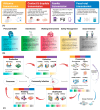Viral Transmission in Sea Food Systems: Strategies for Control and Emerging Challenges
- PMID: 40232102
- PMCID: PMC11941768
- DOI: 10.3390/foods14061071
Viral Transmission in Sea Food Systems: Strategies for Control and Emerging Challenges
Abstract
The SARS-CoV-2 pandemic had widespread and severe impacts on both the global economy and human health. Facing the continuously mutating virus, this crisis has heightened concerns among consumers and businesses regarding viral transmission through seafood, particularly in the face of emerging, unknown viruses, underscoring our preparedness gaps. This review provides a succinct overview of the survival mechanisms of prevalent viruses in seafood, examines potential transmission pathways to humans during seafood processing, and discusses strategies for mitigating their spread throughout the seafood supply chain. Furthermore, the discussion highlights emerging trends in innovative antiviral technologies aimed at enhancing food safety. Person-to-person transmission remains the most likely source of infection within the supply chain. Therefore, it is still imperative to adhere to the implementation of standard processes, namely good manufacturing practices (GMP) and good hygiene practices (GHP), in the seafood business. In light of the significant losses caused by this crisis and the persistent presence of various viruses within the seafood supply chain, efforts are needed to implement predictive and preventive measures against potential emerging viruses. Future research should focus on monitoring and limiting viral transmission by integrating Industry 4.0 applications, smart technologies, and antiviral packaging, maximizing the potential of these emerging solutions.
Keywords: SARS-CoV; aquatic products; food safety; seafood; supply chain; virus.
Conflict of interest statement
The authors declare no conflicts of interest.
Figures



Similar articles
-
The Minderoo-Monaco Commission on Plastics and Human Health.Ann Glob Health. 2023 Mar 21;89(1):23. doi: 10.5334/aogh.4056. eCollection 2023. Ann Glob Health. 2023. PMID: 36969097 Free PMC article. Review.
-
A review of epidemic investigation on cold-chain food-mediated SARS-CoV-2 transmission and food safety consideration during COVID-19 pandemic.J Food Saf. 2021 Dec;41(6):e12932. doi: 10.1111/jfs.12932. Epub 2021 Oct 3. J Food Saf. 2021. PMID: 34898751 Free PMC article. Review.
-
The Impact of COVID-19 Pandemic on Seafood Safety and Human Health.Front Microbiol. 2022 Jun 22;13:875164. doi: 10.3389/fmicb.2022.875164. eCollection 2022. Front Microbiol. 2022. PMID: 35814679 Free PMC article. Review.
-
Use of industry 4.0 technologies to reduce and valorize seafood waste and by-products: A narrative review on current knowledge.Curr Res Food Sci. 2023 Apr 20;6:100505. doi: 10.1016/j.crfs.2023.100505. eCollection 2023. Curr Res Food Sci. 2023. PMID: 37151380 Free PMC article. Review.
-
COVID-19 pandemic crisis and food safety: Implications and inactivation strategies.Trends Food Sci Technol. 2021 Mar;109:25-36. doi: 10.1016/j.tifs.2021.01.004. Epub 2021 Jan 9. Trends Food Sci Technol. 2021. PMID: 33456205 Free PMC article. Review.
Cited by
-
CrAssphage as a Human Enteric Viral Contamination Bioindicator in Marketed Bivalve Mollusks.Viruses. 2025 Jul 18;17(7):1012. doi: 10.3390/v17071012. Viruses. 2025. PMID: 40733628 Free PMC article.
References
-
- FAO . Blue Transformation in Action. FAO; Rome, Italy: 2024. In Brief to The State of World Fisheries and Aquaculture 2024. - DOI
-
- FAO . Towards Blue Transformation. FAO; Rome, Italy: 2022. In Brief to The State of World Fisheries and Aquaculture 2022. - DOI
-
- Tokur B., Korkmaz K. Seafood associated human pathogenic non-enveloped viruses. Ege J. Fish. Aquat. Sci. 2021;38:253–262. doi: 10.12714/EGEJFAS.38.2.16. - DOI
Publication types
LinkOut - more resources
Full Text Sources
Miscellaneous

